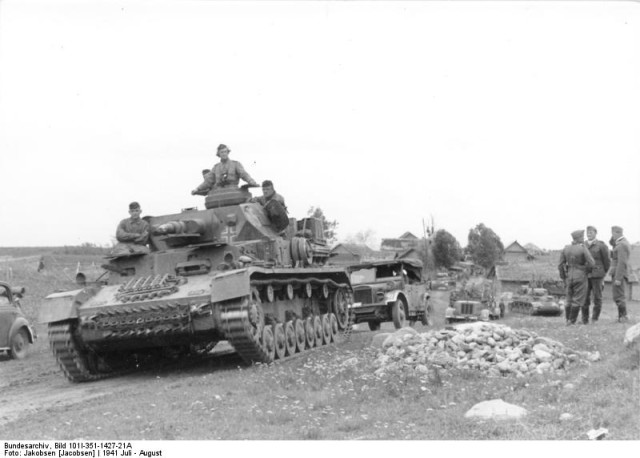

The goal of finding ways to win a war quickly and at low cost instead of engaging in a protracted conflict with heavy losses is probably as old as war itself.
Different armies at different times in history have had varying degrees of success in achieving this aim by using novel techniques, novel weapons, or a combination of them. The Mongol cavalry or the Roman phalanx have left their mark in the history records.
The German army, spurred by the exposed location of the motherland who existed surrounded by potentially hostile nations, without any topographical feature to protect it from invasions, and lacking a raw material base to sustain a high-intensity war for long periods, became particularly keen on finding mechanisms to accomplish a quick victory in case of conflict.
It determined that an offensive war of movement executed with boldness presented the best chances to attain a quick victory at a low cost .
The development of the Panzer division, an organization that did not exist before 1935, is clear evidence of the attempt by the Germans to realize major operational tasks in the field of battle through a war of movement. Its training, organization, and equipment reflect the outcome of a meticulous thought process by its designers, above all, Heinz Guderian. They integrated varied elements into a coherent whole that was more than the sum of its parts. This mechanized formation could accomplish not only a breakthrough of the enemy defensive line but very importantly, it could penetrate deeply through the gap towards the enemy rear sector at a faster rate than what the enemy’s reserves could be sent to plug the holes, thus preventing the establishment of a new defensive line. It could also keep itself safe and strong behind enemy lines .
The difficulty of establishing an organization with this capability is underappreciated by many who believe that it is a matter of putting together a significant number of tanks, infantry in lorries, and bombers and pointing towards a direction of advance.
Both the British and the Soviet armies embarked into a similar path earlier, but they proved less capable of amalgamating supporting units into a purposeful entity that could be smartly controlled by a single commander.
The panzer division structure had to be big enough to be powerful, but its inherently complex logistics demanded it to be lean as well, otherwise the logistic columns would find themselves allocating scarce resources for the benefit of units that were not needed. Just as important, the control of 14.373 men moving along a line 100 km (60 miles) long demanded a finely balanced multi-channel communication system based on radio to receive the information necessary to create a picture of the situation (in real-time) and to arrive at the proper conclusions so the correct orders could be disseminated to the right units at the exact time based on their geographical location . This control included not only the combat troops but also maintenance, logistics and supporting ground and aerial troops.
This intricate process had to be learned in stages. The first armored panzer unit activated in November 1933 was only company-sized and it took a year of experimentation to expand it to a regiment. Ten months later an experimental panzer division of 12.953 men, 4.025 wheeled vehicles, and 481 tracked vehicles demonstrated during maneuvers that it had a place in the German army. On 15 October 1935, the army activated the first panzer division and ordered the formation of two more. Overall the panzer commanders required almost two years of trials to develop the first workable organization.
The Soviets created their first armored brigade in May 1930, a full 4 years before the first panzer regiment, and two years later they formed the first mechanized corps comprising 2 mechanized brigades, 1 rifle/MG brigade, plus reconnaissance, chemical, engineer, signals, AA battalion, and services. It contained 490 tanks and 60 artillery guns .
By the time the Germans announced their first panzer division, the Soviets had activated 4 mechanized corps and 16 mechanized brigades. The Red Army enjoyed more than enough time to develop the processes to control large effective armored units, at least in theory.
When Germany invaded Poland on 1 September 1939, the motorized corps (composed of two mobile units: either panzer or light divisions) was the largest armored formation in the Wehrmacht. The Panzerwaffe comprised 7 panzer and 4 light divisions at the time.
In the meantime, the Soviets increased the size of their armored formations. The mechanized corps grew to contain 560 tanks and was renamed a tank-corps. However, they kept the 4 original corps and decided not to activate more because of problems controlling such large formations, an indication that their control methods were experiencing problems.
Nevertheless, on paper, both armies looked similar at the outset of World War 2.
After the invasion of Poland, things started to change markedly. The Germans considered that the panzer division and the motorized corps organizations proved their worth and after a comprehensive analysis of the results, proceeded to improve them. For the invasion of France, eight months later, they reduced the number of tanks in the panzer division from 340 to 258 (25% reduction), and significantly, they created the first panzer army in the history of warfare, naming it Panzergruppe. With 3 motorized corps, it became the largest armored formation in the Wehrmacht and the world.
The Red Army chose an entirely different direction. It deemed its tank corps too large and clumsy and rather than improving them they were disbanded . The tank brigade became the largest armored formation in use in the Soviet Union. This formation was less than one-tenth of the size of a Panzergruppe.
The tank itself did not fall from favor. On the contrary, its production accelerated its tempo, but the large quantities of manufactured tanks were assigned to independent tank brigades and to tank battalions allocated to rifle divisions, transforming them into armored-infantry formations. The tank brigades remained as the only units capable of limited operational maneuver.
Less than a year later, after the invasion of Finland, the Russian discovered that the dispersion of tanks to the rifle divisions was in error and they removed them to activate more tank brigades .
The Battle of France reaffirmed the dramatic success of the panzer division and confirmed that the Panzergruppe was a very powerful formation that provided enormous operational capability when backed by heavy air support. Therefore, the Wehrmacht activated 4 Panzergruppen for the Russian campaign (each one supported by one Fliegerkorps) and once more, fine-tuned the organization of the panzer division which became optimal at this stage of the war. The 1941 panzer division was organized around a ratio of one panzer battalion for every two infantry battalions and the number of tanks was slashed to 206 (20% reduction compared with the size on 10 May 1940). The elimination of one panzer regiment in the panzer division meant a corresponding increase in the density of supporting troops (because the infantry, artillery, engineers, etc. had to support fewer panzer battalions and their resources were not spread too thin). Notwithstanding some loud voices against this, results would demonstrate the great effectiveness of this improved organization .
Surprised by the success of the German arms in France, and especially the armored formations, Stalin ordered on 21 May 1940 the creation of mechanized corps on lines similar to German motorized corps, that is, consisting of 2 tank divisions and 1 motorized infantry division.
Following the order, the Red Army activated 8 mechanized corps and ordered a 9th in October of the same year. The organization of the new mechanized corps featured a size twice as big as the one disbanded only the previous year because they could not be suitably maneuvered. This meant that the Russians had to quickly find formulas to control them and then to train the troops before war broke out. Despite the apparent late decision, these mechanized corps enjoyed the same time for training as the new panzer divisions that Hitler ordered after the fall of France .
Unfortunately for the Russian people, the Soviet High Command believed it knew more about handling armored forces than it did. After the fall of France, General Gamelin provided the Russian military attaché in Paris an extensive report of the reasons for the defeat and recommended its study to avoid falling to the same fate. The GRU's Information Department analyzed this report, prepared its own and presented it to Zhukov. The report included an analysis of the use of the German panzer corps and the panzer group, but Zhukov, who had defeated the Japanese army in 1938, arrogantly told the startled intelligence officers that he did not need it .
The haughty self-confidence aside, the Soviet Chief of the General Staff proposed on 21 February 1941 to increase the number of mechanized corps to 30. Soviet intelligence estimated that the Germans would deploy 10 motorized corps with 10,000 tanks and this probably triggered the huge increase: a force 3 times as big as the attackers should suffice to defeat any invasion.
The late order for the activation of this new wave of mechanized corps meant, however, that they received neither their full complement of equipment (only 52% of tanks) nor all the staff (75% of personnel). Worse yet, the training of the personnel could not be completed on time .
If we forget for the moment the mechanized formations, the bulk of both armies, consisting of infantry (or rifle) divisions, were similarly equipped and capable. Since the Russians arrayed more infantry divisions and had an enormous advantage in replacement capacity, the Red Army enjoyed a great advantage. A German invasion contemplating only infantry armies would be hopeless.
Adding armored units to the equation, both armies deployed significant numbers of armored and motorized divisions but again the Russians had a substantial quantitative superiority which, to the Soviet leadership, appeared to indicate that the Teutons had a very low chance of achieving victory.
However, it was how these armored units were used that made a huge difference. The operational dexterity of the Wehrmacht armored formations supported by strong tactical air support gave them a qualitative edge that at the time could not be adequately measured. Only with hindsight, we can see that the blitzkrieg method was a combat multiplier. The magnitude of this multiplier is probably in the order of 4X-to-5X, that is, a 1941 panzer corps was arguably 4 to 5 times more effective than its Soviet equivalent .
This operational skill turned out to be more vital than the quality of the tanks, as demonstrated by the fact that the mediocre Panzer Kpfw. II, the most important German tank during the invasion of France and inferior in armor and firepower to British and French tanks proved adequate to thoroughly defeat their western enemies when fighting as an element of a panzer division organization.
Wisely, the Heer recognized that with better tools the panzer divisions would be even more formidable and thus, from the beginning embarked in an aggressive plan to improve their equipment .
This enhancement was not limited to the tanks. By June 1941 the Germans deployed 1.055 armored half-tracks, most of them to partially equip the infantry battalions of the panzer motorized brigade. These 7.8-ton armored vehicles with a capacity of 10 soldiers and 2 crew members could fight close to the tanks and consequently provided enhanced support. The Sd.Kfz. 251 became a highly successful AFV and its production would increase dramatically every year .
All but three of the 17 panzer divisions received enough stocks to equip at least 1 motorized infantry company. The Germans selected two of these armored divisions and equipped them exceptionally well. The 10th Panzer division included 1 armored infantry battalion fully equipped with these half-tracks while the 1st Panzer division boasted 2. Also, roughly half of the panzer divisions received additional half-tracks to outfit 1 company of the armored engineer battalion. In contrast, the Red Army lacked armored carriers for its motorized infantry and relied exclusively upon lorries, as did the great majority of the German motorized infantry companies.
The Germans also introduced the concept of the assault-gun. A fully tracked armored fighting vehicle based on the Panzer III chassis and armed with a short-barreled 75mm low-velocity gun. These turretless AFVs had a thick armor that allowed them to fight in the spearhead of the battle supporting the infantry divisions responsible for piercing an enemy defense line. Its operational doctrine differed from the tank and the Germans trained these units as line-of-sight artillery.
On the eve of Barbarossa, the StuG III, the name of this AFV, appeared for the first time in substantial numbers. Overall 284 of them participated in the invasion equipping 11 independent assault gun battalions and 7 assault gun batteries (5 independent and 2 fighting as part of the SS Das Reich and SS Leibstandarte Adolf Hitler). The concept proved highly successful and with improvements, the vehicle remained in production throughout the war in ever-increasing numbers .
The Red Army did not deploy assault guns early in the war, but later copied the concept in the form of the SU-76 which appeared for the first time late in 1942. They played no part in Barbarossa but eventually (starting in 1943) the Russians manufactured this self-propelled gun in huge quantities .
The quality of German tanks also improved markedly as the war progressed. The Wehrmacht strived to replace the obsolete Pz. Kpfw. I and II as soon as possible, and by June 1941, for the first time since the start of the war, the Pz. Kpfw. II was relegated to a secondary role while the modern Pz. Kpfw. III replaced it as the main German battle tank, greatly increasing the shock power of the panzer divisions.
The German tank park improved, but not to the extent of giving the Germans an absolute qualitative advantage over the Russians who also possessed more tanks than the rest of the world combined.
The quality of tanks is conventionally ascertained by evaluating three characteristics: firepower, armor, and mobility . These are not the only important attributes, but we will start with them to weave an explanation that allows for a proper comparison between the armed forces of the USSR and Germany.
The numerous tank models employed by both antagonists in 1941 complicate this assessment, but we can provide clarity by classifying these tanks into three main categories: Very light tanks (up to 9.5 metric tons for German tanks and up to 10.25 metric tons for Soviet tanks), light tanks (heavier than the previous category and up to 19.5 tons), and medium/heavy tanks (over 19.5 tons in weight).
The Germans did not have heavy tanks in 1941, only the Red Army did. Rather than creating an additional category, these tanks will be evaluated along with the medium tanks.
The tanks that belong within the same category are broadly similar in performance and can be easily compared, although we will underline any exceptions. Tanks in the next category tend to be superior.
AFVs in a lower category trying to engage tanks in a higher category will do so at a disadvantage.
Very light tanks appeared first and by June 1941 its production had either stopped or else manufacture of limited units continued. Light tanks, in general, appeared afterward. Medium and heavy tanks represented the state-of-the-art at the time and both combatants strived to assemble as many as they could.
The following two tables classify the tanks in the said categories and describe their deployment in both armies.
The 17 panzer divisions ascribed to the 4 Panzergruppen and the 5 independent tank battalions featured 1.200 Very light tanks , 780 light tanks , and 1.430 medium tanks on 22 June 1941. This total does not include 234 command tanks, 108 flamethrower tanks, and 49 foreign tanks (10% of the total).
Overall the Wehrmacht allocated 3.801 tanks for Barbarossa and kept 1.518 (36%) in strategic reserve, including the tanks in the 2nd and 5th Panzer divisions (OKH reserve).
The weight of each tank model in the table corresponds to the heaviest variant present at the time. Newer variants of the same model weighted more as a rule.
The 25 mechanized corps assigned to the 6 western fronts (including the Stavka reserve) totaled 6.537 very-light tanks , 5.016 light tanks , and 1.808 medium and heavy tanks on 22 June 1941.
The Red Army earmarked 15.470 tanks of all types to face the Germans of which the mechanized corps received 13.361 (86%). Many other formations (including the rifle divisions) received the balance.
The Soviet High Command kept a strategic reserve of 9.984 tanks (39%) including those allotted to 5 mechanized corps in rear areas (23rd, 27th, 28th, 29th, and 30th), far from the front.
Using a Firepower-Armor-Mobility (FAM) model as a basis of comparison, we will start evaluating the relative quality of the tanks in each category.
Starting with the very-light tank category (Class A), we will compare the tanks that represented the bulk of the AFVs in this class: the German Pz. Kpfw. I and Pz. Kpfw. II against the Soviet T-26. The firepower is represented by the ability to penetrate armor at different ranges. The armor as the maximum thickness and corresponding inclination of the armored plates and the mobility as the maximum speed of these vehicles.
From the table, we can see the inability of the Pz. Kpfw. I to penetrate the T-26 armor from any distance. The T-26 was invulnerable to the German tank fire because the latter only possessed a pair of machine guns as weapons. The 45mm gun of the T-26, in contrast, punched through the armor of the Panzer I at any battle range (up to 1000m). Speed turned out to be the only advantage of the German tank, although it was only useful to escape it would seem.
The Pz. Kpfw. II was a little better. Its armor remained as vulnerable to the Soviet 45mm gun like that of the Pz. Kpfw. I, but its 20mm cannon could penetrate the T-26 armor at short (under 500m) distances.
We, humans, have difficulty grasping tabulated information and are better at interpreting images. One popular wargame showed the ability to transform the information of the table above into a single helpful image by using 4 numbers and a letter, as exhibited below:

A straightforward comparison of these FAM images is enough for a layman to understand the superiority of the T-26 over the Panzers I and II.
The data from the previous tables unambiguously reveals that the 4.961 T-26 not only outnumbered but outperformed the 1.200 Panzer I and II even without taking into consideration the other 1.576 T-37 and T-38 available to the Red Army. Therefore, in this category, the Red Army had a distinctive advantage.
Comparing Class B tanks (light tanks), the situation is somewhat different. The Panzer 35(t) and 38(t) of Czech manufacture could neutralize the BT-7M from any angle at distances up to 1.500m. The Soviet tank could also destroy the German tanks at ranges of 1.000m or less giving the Germans a slight edge (terrain factors usually restricted maximum battle ranges to 1.000m). The BT-7 partially compensated this disadvantage by its superior mobility. Overall, there is no clear combat advantage, except when contrasting the Panzer 38(t) Ausf. E that boasted thicker armor. The BT-7 had to hit the side armor at ranges of 500m or less to destroy this tank, whereas it was vulnerable at all ranges.
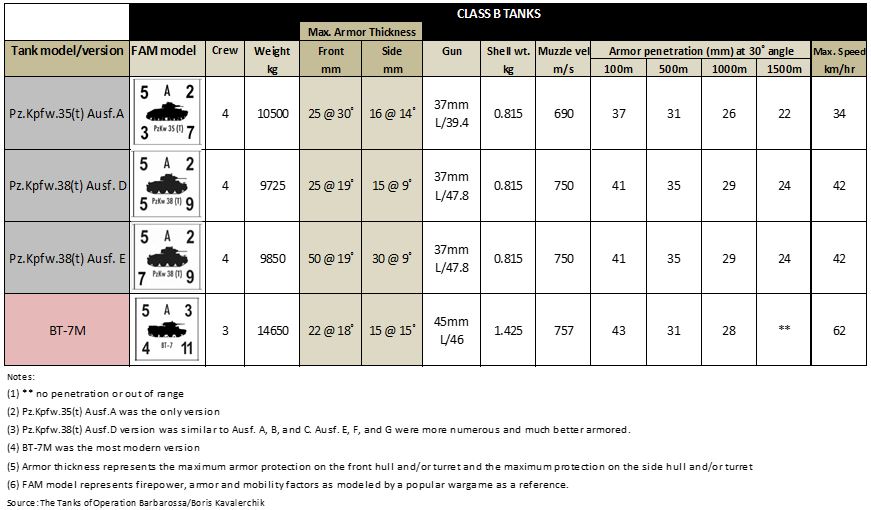
Overall, as a group, the 780 light German tanks had a modest qualitative advantage that the 5.016 Soviets light tanks (3.937 BT-7) could theoretically offset with their significant numerical superiority.
At the outbreak of the Russian campaign, the German industry’s best models in large scale production remained the medium-weight Panzer III and Panzer IV .
The T-34 and T-28 medium tanks and the KV-1, KV-2, and T-35 heavy Soviet tanks belonged to this category (Class C). Although the T-28 had adequate performance, by 1941 the Red Army had stopped the production of this tank and the T-35 in favor of the T-34 and KV models.
Theoretically, the T-34 and KV tanks held a decisive superiority over the adversary’s Panzer III and Panzer IV in firepower and armor protection. The tabular data above shows that the KV was invulnerable to the fire of the German tanks and the T-34 could only be destroyed by the Panzer III armed with the 50mm gun at ranges of 300m or less. The Soviet tanks, armed with a powerful 76mm gun, could destroy the German tanks from any angle and at any distance up to 1.500m, except the Pz. Kpfw. III Ausf. J whose frontal armor had been increased to 50mm. Even in this case, the T-34 could pierce its frontal armor at 1.000m and the KV-1 at 500m.
Additionally, the T-34 had the best mobility of all tanks so, using the tabular data presented, it would not be difficult to infer that it was the best tank employed in Russia in 1941.
The previous conclusion only takes into consideration AP (armor-piercing) rounds: projectiles manufactured with a very hard head meant to penetrate armor and a body that included a small amount of TNT in the casing designed to explode inside the tank, usually with fatal consequences to the tank and crew.
The Germans also employed APCR (armor-piercing, composite-rigid) shells that were solid and did not contain TNT. These lighter shells could be fired at higher muzzle velocities giving them more punch to breach the armor. They had two disadvantages: the lack of explosive charge caused less destruction inside the tank, but enough to at least incapacitate some crew members. The other drawback is that this shell loses speed fast and at longer shooting distances the standard round performs better.
Once the APCR rounds are included in the analysis (see next table), we can ascertain that the T-34 and KV tanks were far from invulnerable to the German guns. Even the 37mm gun (at distances under 300m) had enough power to destroy the T-34 (it could also destroy 87% of the tanks in the mechanized corps at 1000m with the standard AP round).
We can also see that Hitler was right in ordering the Army Weapons Department to arm the Panzer III with the long 50mm gun. Had this department followed his order (it did not, in a remarkable case of insubordination), the Panzer III would have been able to destroy the T-34 at distances of almost 1.000m instead of 300m with the short cannon.
Despite the improvement in German firepower owing to the APCR rounds, it still is obvious that the medium and heavy Soviet tanks enjoyed a significant advantage in combat over the German tanks when only firepower, armor, and mobility enter in the equation .
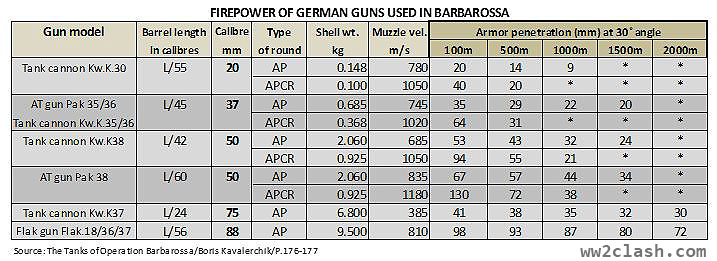
To the qualitative dominance of the Red Army’s class C tanks, we must add that its 1.808 medium and heavy tanks outnumbered the Wehrmacht’s 1.430 medium tanks by a factor of 1.26-to-1. Since this class dominated all the other classes it may appear that the German armored forces faced an intractable problem: significant numerical inferiority in all tank classes combined with substantial qualitative inferiority in 2 out of the three classes, one of them the most important.
However, when the war commenced the Germans faced fewer problems against the Soviet tanks than the previous analysis would suggest. Why?
There are three reasons: (a) The traditional FAM model to evaluate tank performance is incomplete, some very important factors are not considered, (b) The Soviet factories delivered T-34s and KVs with serious manufacturing flaws in the haste of increasing production making them markedly different from the approved tested designs while the German mass-produced tanks did not experience this divergence, and (c) the performance of an armored force depends on factors that go beyond the quality of the tanks.
A tank is a weapon-system composed of several sub-systems linked together to effectively execute an overall mission. Each of these sub-systems must carry out its job to accomplish the task. If the link is broken, the success is impaired.
To destroy an enemy tank, the crew must spot it first. The Panzer III and IV enjoyed 2 crucial advantages over the T-34 that gave them the lead in this area:
A turret with a crew of 3 men (commander, gunner, and loader) versus the T-34 turret which had space for only 2 men (a commander that also worked as the gunner, and a loader). The German commander could devote his full attention to scan the battlefield, identify threats, spot the next target, see the actions of the other tanks in the platoon, receive orders from the platoon commander and convey them to this crew, direct the actions of his tank (fire and move), and in general acquire better situational awareness. The Soviet commander was overtasked: if he tried to maintain situational awareness his job as a gunner was poor, while if he focused on the gunner duties, he lost situational awareness.
A cupola in the top of the tank with 5 visors that permitted all-around vision while fully protecting the commander from fire. In place of a cupola, the T-34 got a PT-6 periscopic sight whose optics qualities, narrow field of vision, and inconvenient location hindered its use. As a result, the Soviet crews did not use it in battle and fought with partially open hatches that gave them less protection and an inferior view (they could not scan continuously).
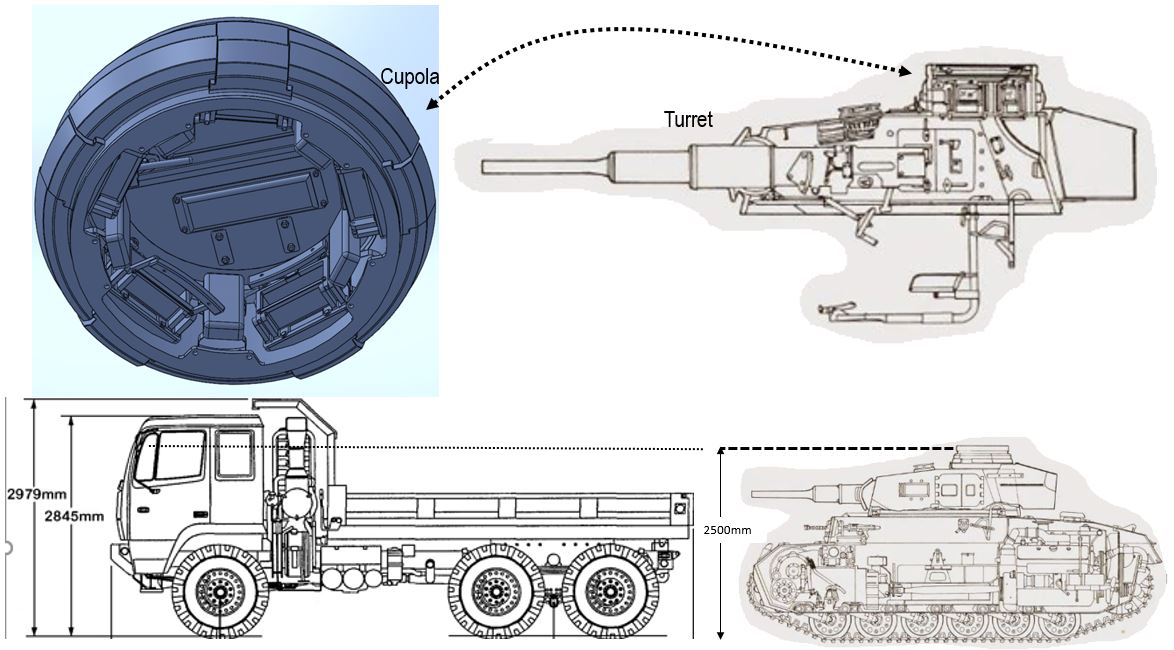
Once a tank identifies its target, the next step is to engage it. The gunner now needs to train his telescopic sights on the objective.
After the German commander gave his gunner an approximate direction to the target, the gunner turned his turret in that direction and started his search. The German TZF4 and TZF5 telescopic sights proved superior to the Soviet TMFD-7 and PT-4-7 sights thanks to significantly wider field of view and anti-reflective coating. The first allowed the German gunner to scan an area 3 times as large as his Russian counterpart at the same range, while the second permitted more light to get through, making the target clearer against the background, especially under low-visibility conditions: dawn, dusk, overcast, rain, and snow. Also, the cramped space inside the turret and poor installation of the optics made for a difficult operation on the part of the Russian crew. To complicate matters, power traverse did not have enough power to turn the turret when the tank had an inclination more than 15 degrees and the crew preferred to turn it manually despite being a very fatiguing job. If the Germans hit the T-34 turret, even if it was not perforated, the optics became disabled.
To add insult to injury, the T-34 lacked shock absorbers. As a result, the tank rocked in reaction to speed changes, stops and uneven ground for a long time after it stopped. The consequence is that a stationary target appeared to bounce in the telescopic sight making it impossible to engage it until the swaying ceased. All this reduced the practical rate of fire to 2-4 shots per minute .
This meant that the German tanks usually fired first and hit the adversary more often.
The T-34 possessed a powerful 76mm gun that surpassed the power of the 50mm gun (although it was less accurate). Yet, it is the shell and not the gun that destroys a target. Soviet AP ammunition (45mm and 76mm) because of overheating during manufacturing, suffered from high brittleness, drastically reducing its penetrating power throughout the summer of 1941 as compared with the theoretical value. In the autumn of the same year, the problem was partially addressed by installing undercut localizers in the projectiles. Still, the quality of the manufactured AP shells remained inferior to their German counterparts for the whole of the war.
But a bad shell is better than no shell at all: in June 1941 the 76mm AP projectile was in drastically short supply. On average, every 76mm gun only received 12 shells (or 15% of requirements) forcing the Soviet crews to fight often with HE shells aimed at the tracks or sides of the German medium tanks.
While the T-34 tanks had thicker armor, manufacturing flaws diminished its quality abnormally. The German heterogeneous (hard surface and malleable nucleus) and rolled armor with carefully applied welding was excellent, while Soviet armor presented weak points and proved susceptible for penetration at those spots even by low-caliber guns (at weld joints the armor was 2X to 4X weaker, which was equivalent to the armor of a light tank). Even as late as the Summer of 1942 between 45 to 90% of the Soviet armor developed cracks . If hit there the outcome was often catastrophic.
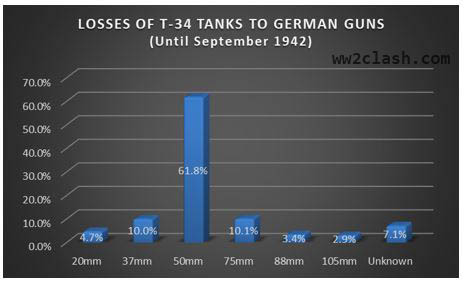
The Germans equipped all their tanks with a radio (45% had transceivers and 55% receivers) while only the command and heavy tanks possessed radios in the Red Army. 25% of T-34s came equipped with them. The range and reception quality of German radios were superior as well.
Using them the Wehrmacht tanks could fight as a team instead of individually, isolating sections of Russian tanks and defeating them in detail.
The cross-country mobility of the T-34, vital in the battlefield, topped the German tanks thanks in great part to the lower ground pressure . But the mobility of the German tanks to reach the battlefield was much better because of the low-reliability of the mass-produced T-34. As late as early 1943, 77% or more of these tanks broke down in the first 300 km of march. This was so, despite the factory warranty of 1.000 km on the vehicle and 200 hours on the engine. These tanks could be repaired, but the mechanized corps lost a great number of tanks moving to and from the battlefield. For example, in the first 4 days of the war, the 8th MC marched 500 km and lost 50-60% of its tanks before entering in contact with the enemy.
Problems with engines (that lasted 110 hours or less) and bad transmission were the weak points of the T-34 and KV tanks .
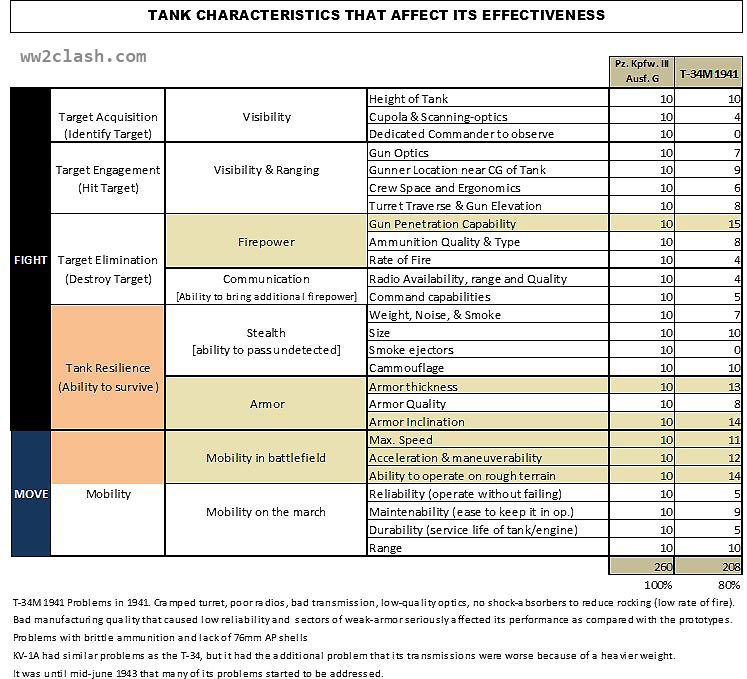
In stark contrast, by October 1941, German tanks had covered 11.000 to 12.500 km and remained combat effective. Even though they had been repaired and maintained more than once, their reliability is remarkable.
A bad tank is better than no tank at all.
All of these factors can be taken into consideration in a FAM’-AECS model. The FAM’ indicates that ammunition performance, armor quality, and mobility on the march are incorporated. The AECS denotes target acquisition, target engagement, communication, and stealth .
Using this model , we infer that the Panzer IIIG was an all-around better tank than the T34 M1941 during the Barbarossa period.
When considering complete armored forces, tank quality is important, but not the decisive factor.
Armored operations are more akin to Formula-1 racing than to a boxing match. It is not enough to have a great racing car. A highly skilled pilot must exploit the advantages of his vehicle, and a first-rate service team in the pits is indispensable.

During Barbarossa, German tanks crews handled their complex vehicles with skill owing to adequate training. Fully qualified Soviet crews manned the older T-26 and BT tanks. However, the training on the newer T-34 and KV tanks had not progressed well. Only 150 KV and 150 T-34 crews finished their drills by the eve of the invasion to operate 469 KV and 864 T-34 tanks (23% overall) . The rest of the crews had minimal instruction. Unskilled operation on the part of the troops aggravated the already high rate of malfunction of these tanks, which presented numerous manufacturing problems. It also prevented them to make the best use of the tank capabilities. For instance, it was typical for T-34s to fight a battle in second gear reducing the off-road mobility of the T-34. Change of gears without stalling the engine necessitated mastery by the driver and these drivers were very scarce.
The German logistics system, fine-tuned since the beginning of the war, could sustain offensives of unprecedented depths while minimizing pauses between operations. The Soviet supply system proved inept in Poland and fragile afterward, allowing the Germans to frequently obtain fire superiority.
The maintenance and repair organization of the Panzer divisions had been decentralized to refurbish the tanks in the field instead of shipping them to the factories. Each Panzer regiment contained a maintenance company of between 120-200 men that was carefully equipped with vehicles, tank-transports, and recuperation and evacuation primer movers, along with the necessary spare parts, machine tools, electricity generators, gas welders, tools, and fixtures. It could repair about 30 tanks simultaneously. A maintenance platoon was assigned to each panzer battalion and a maintenance detachment to each panzer company.
The Red Army’s maintenance system compared unfavorably with the German. Even considering that on the average, the mechanized corps had only 52% of the tanks allowed per the Tables of Organization and Equipment, its repair units possessed even lower levels of authorized equipment: 41% of trucks, 35% of mobile repair shops, 28% of charging stations and 19% of mobile gas tanks. Spare parts stocks reached only 46% of the requirements for tanks and 54% for trucks. And the number of spares was based on peace-time usage which was a fraction of the needs in wartime .
The radio-based communication networks and suitable operational procedures enabled a robust command and control system in the Panzer divisions. The Soviet system lagged behind the German, in part as a result of inferior communication equipment.
Divisional, corps and army generals commanding the Panzerwaffe had demonstrated in previous campaigns their skill, boldness, and flexibility to learn from experience. The Soviet commanders, impacted by the recent purges, only rarely displayed similar qualities. Besides, 17 of the 25 Mechanized Corps had only 5 months of activation, but even the corps that had years of theoretical and practical combat experience failed to distinguish themselves in combat.
The Blitzkrieg doctrine had been refined to excellence, integrating competently other branches like infantry, artillery, and aircraft to create all-arms teams. The experience gained allowed the Germans to activate the largest mechanized formations in the world.
Toughness and courage were not lacking in the Red Army. Neither good equipment. But it made use of its time in a much less efficient manner than the German army. In 1941 the RKKA faced the most professional army in the world confident in its capabilities and strengths. Reality would soon demonstrate that despite equivalent equipment quality and enormous advantage in numbers, the Soviet armored forces stood inferior to the Panzerwaffe.
The Russians allowed this qualitative difference to grow to such an extent, that when hostilities started, they were shocked with surprise. Only the years of preparation and German mistakes bought them enough time to avert defeat.